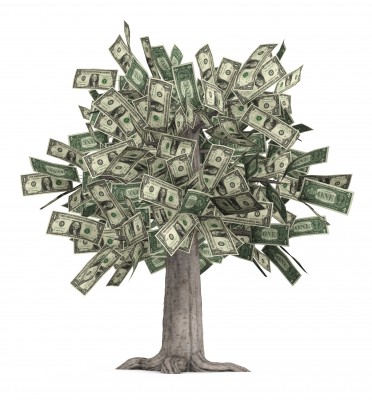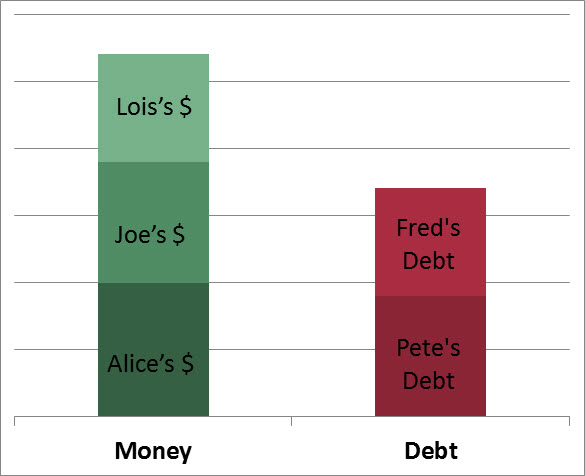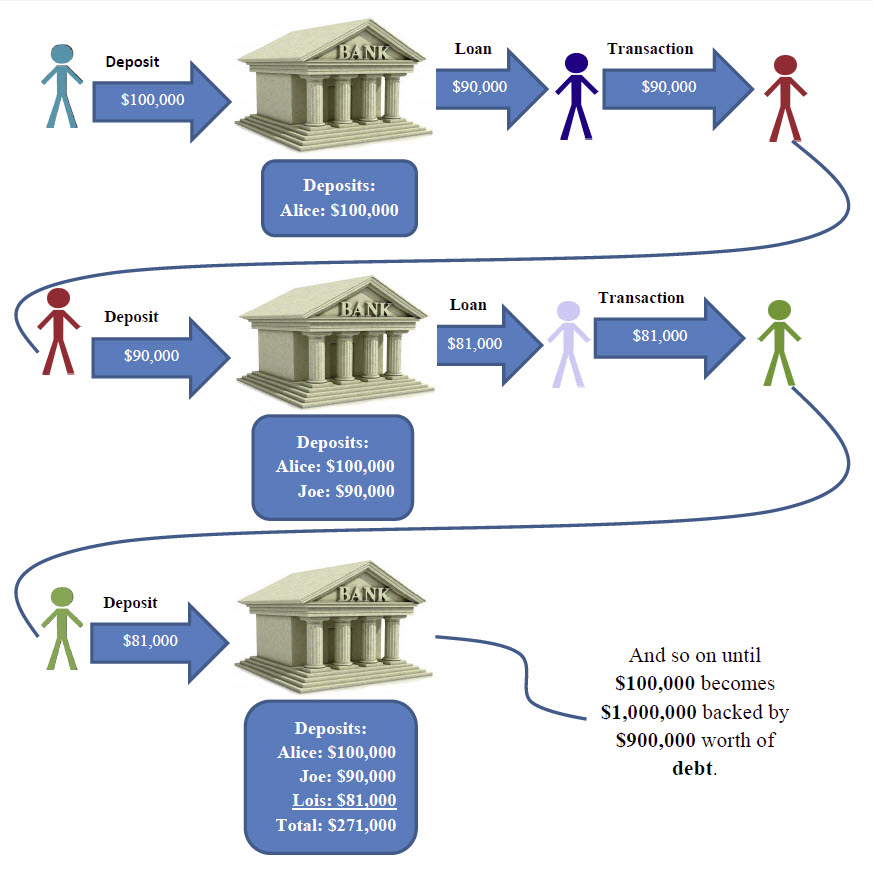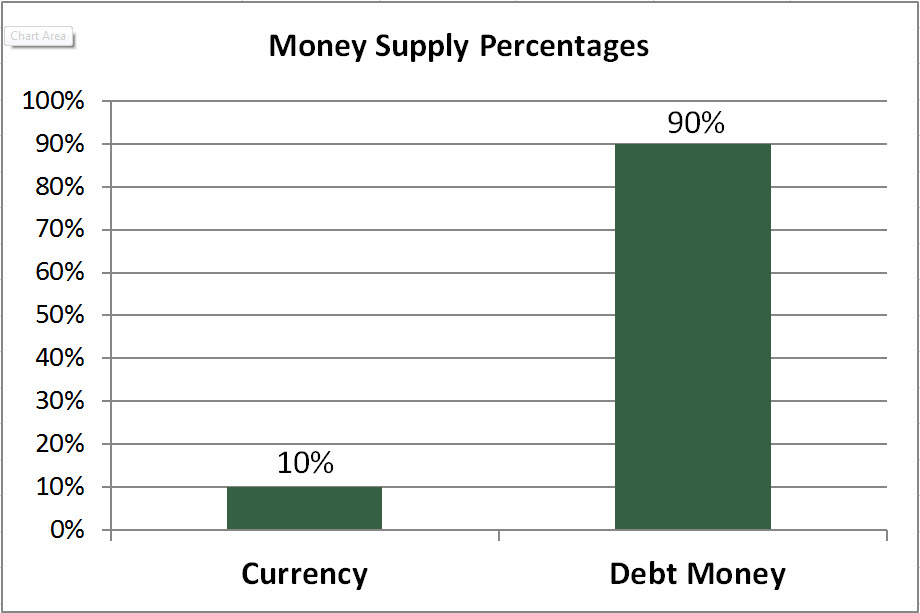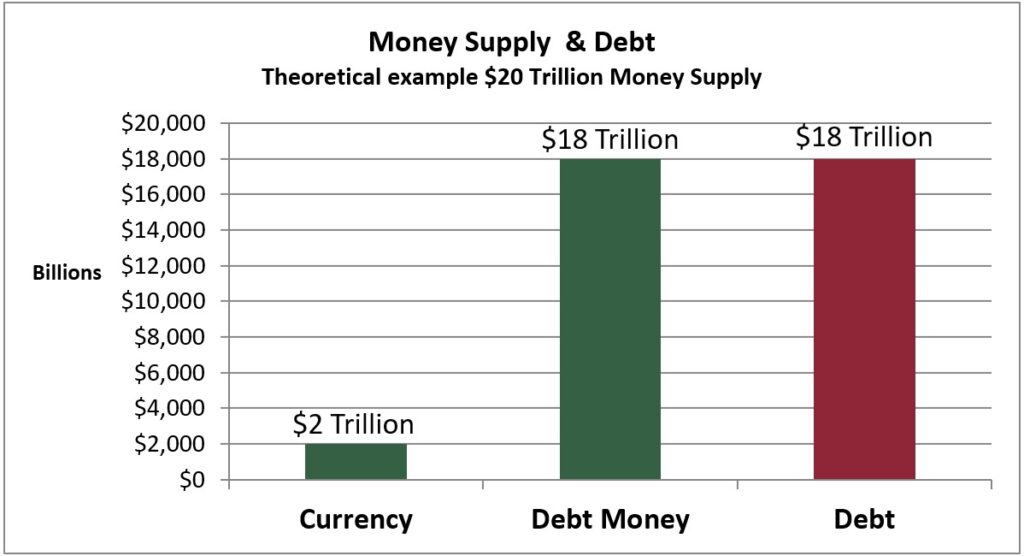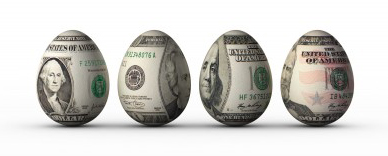It is rare to hear discussion of the fractional reserve banking system creating money, though authorities in the banking and government sectors have begun to publicly admit that it does. The process hinges largely on the purpose of money and what we use to fulfill that purpose.
“…the majority of money in the modern economy is created by commercial banks making loans.”
Money Creation in the Modern Economy Bank of England Quarterly Bulletin 2014 Q1
Money is a human invention used to make it easier for people who don’t know and trust each other to exchange goods and services. Without necessarily having value of its own, money is used to represent value in an exchange. Banks don’t have printing presses in the back room where they print up cash bills, but cash isn’t what most people are using for money most of the time. In the modern economy what most people use for most buying and selling is bank-account entries, which they transfer among themselves using checks or cards or electronic transfers.
Bank-account money works a little different than cash. When you deposit money in a bank, what you get from the bank as a deposit record is the bank’s promise to pay that amount of money back to you on demand. That’s a little different than having cash held for you for safe keeping. Money in bank accounts consists of bank IOUs, and there is no guarantee that the banks will actually be capable of paying them. That’s why bank-account money has to be insured through the Federal Deposit Insurance Corporation. Bank IOUs are part of the money supply because we use them as money.
Creating Money in the Money Multiplier Model
When banks make loans, they do it by issuing IOUs, thus creating the money at the time of the loan. If that seems outrageous or less than credible to you, you’re not alone. This isn’t something that’s publicized or talked about a lot, but this is the reason that bank money can evaporate and banks can collapse. See How the Banking System Works.
There’s a name that”s been used in monetary/economic circles for the banking system’s money-creation process, they call it the money multiplier (you can Google it). The way it’s currently done has been streamlined a lot, as will be explained below, but the principle and the fact of bank money creation remains.
To demonstrate the fractional reserve banking system’s money multiplier principle, we’ll look at a simplified theoretical example. Let’s say we have a fractional reserve banking system where the reserve requirement is 10%. The banks are allowed to lend out 90% of the amount they have in depositors’ accounts, but they have to keep at least 10% in reserve.
To simplify the demonstration, we’ll lump all banks into one and just work with the bank. We start from zero and suppose that Alice comes into the bank and deposits $100,000 in currency. The bank now has $100,000 on deposit of which it can lend out 90% or $90,000.
The bank lends $90,000 to Pete. Pete pays the $90,000 to Joe for a boat, and Joe, rather than carrying $90,000 around in a briefcase or putting it under his mattress, deposits it in the bank.
Now the bank has $190,000 in deposits, and it considers the new deposit brand new money. Therefore, it’s free to lend out 90% of this new deposit. It now lends $81,000 to Fred, which Fred pays to Lois for design and decorating services for his business office. Lois, of course, deposits the $81,000 in the bank. Once again, the bank considers it has brand new, fresh, debt-free money on deposit. Now we have:
$100,000 Alice
$90,000 Joe
$81,000 Lois
$271,000 Total
By these three steps, the money supply has gone from $100,000 to $271,000. Note that Alice, Joe, and Lois all consider the money they have on account is their own money with no strings or debts attached. Pete and Fred may be making or not making monthly payments on their debts, but with regard to Joe’s and Lois’s deposits, that’s no concern of the bank and no concern of the account holders. As far as they’re concerned, that money is real money, free and clear.
If you continue this process until the re-deposited amount gets down to near zero, eventually $100,000 currency turns into about $1,000,000. The process creates $900,000 of debt-based money out of $100,000 currency. Thus, we’d get a money supply that was 90% debt-based and 10% currency.
If we assign actual numbers and include the debt on the graph, our system would look something like this:
The description above is based on the traditional story of fractional reserve banking to show how the money multiplier principle allows banks to create money. This isn’t what banks actually do.
What the Banks are Really Doing
In modern times particularly, there are a couple of major differences between the story above and reality. The biggest difference is that when a bank makes a loan, they don’t generally give the borrower cash. They write a check or make an account entry. Bank-account money. It works a little different than cash.
If there’s a 10% reserve requirement, it means the banks have to maintain reserves equal to 10% of their customer deposits. The reserves can be either cash in their vault or money in their reserve account with the central bank. So, in the money-creation scenario above, when Alice comes into the bank with her $100,000 cash, the bank makes an account entry that Alice has $100,000 on deposit, and they put $100,000 cash in the vault.
Now…they could look at this on the basis that they have to hold onto at least $10,000 of that cash to cover the reserves for Alice’s deposit, and they’re free to lend out the rest. But they could also look at it another way. They have $100,000 cash in the vault, which is 10% of what? — a million dollars. And they only have $100,000 on deposit. Therefore, they now have room for another $900,000 in deposits to still be within their reserve requirement. And they can create those deposits by making loans. This is how they look at it.
So in the simplified example used above, what they’d do is just plunk the $100,000 cash in the vault and start making loans till they reached $900,000. They don’t send the cash out the door and then wait for Joe and Lois to trundle back into the bank with briefcases full of cash. When they lend the $90,000 to Pete to pay to Joe for a boat, they just cut right to the chase and make a deposit entry in Joe’s account.
“The actual process of money creation takes place primarily in banks. …checkable liabilities of banks are money. These liabilities are customers’ accounts. They increase when customers deposit currency and checks and when the proceeds of loans made by the banks are credited to borrowers’ accounts.”
Modern Money Mechanics,
Booklet published by the Chicago Federal Reserve bank 1994
As strange and outrageous as this may seem if you weren’t previously aware of it, this is standard procedure for commercial banks and this is how most of what’s considered money in the economy is created. It works, to the degree that it does, because commercial banks are in a unique position not shared by any other type of corporation or organization. The bank-account balances that you and I are passing back and forth as we make exchanges, are liabilities on the banks’ balance sheets—bank IOUs. As the holders of deposit accounts, they’re issuing IOUs that the entire economy is using as money. That is the thing that puts them in a position to create money by making account entries.
Balance Sheets
If you are unfamiliar with balance sheets, the essence is this:
It has two sides with Assets on the left side and Liabilities and Equity on the right side. Assets are valuables that you have in your possession whether you owe money on them or not. Liabilities are debts, and Equity is the value of what you own free and clear. The two sides add up to the same amount. The worth of your assets is equal to the amount of money you owe plus the value of what you own without obligation.
For example, if you buy a $500K house with a $100K down payment and a $400K mortgage, your home-owner balance sheet would look something like this.
If the value of your house goes up and you don’t borrow any additional money against it, then the value of your equity goes up correspondingly. If the house is now worth $600K and the mortgage is still $400K, your equity would be $200K.
Likewise if the value of the house goes down, your equity is reduced. If the house value dropped below $400K then your equity would become negative. The balance sheet always balances.
So back to the banks, the way they create money and keep their balance sheet balanced is by issuing their IOUs in exchange for borrowers’ IOUs. If you get a mortgage loan from a bank, the promissory note that you sign agreeing to pay back principal plus interest is an asset for the bank–a promise of future money. The account entry that the bank makes creating the principal proceeds of the loan is a liability for them, their IOU. The trick of it being that their IOUs happen to be what the rest of us are using as money—thus, they are creating money.
The section of the bank’s balance sheet for our imaginary scenario above would look like this:
The evolution that put them in a position to legally do this comes from the core principles of fractional reserve banking just as it was depicted in the movie It’s a Wonderful Life (see How the Banking System Works.) As soon as we say that George Bailey is allowed to take the depositors’ money out of the safe and lend it to Joe and Mrs. Menklin to buy their houses, we’ve given the banks the power to create money. All they’ve done when they create deposits out of nothing is the logical, efficient streamlining of the process.
Real World
The above examples are very simplified of course. In reality it’s more complicated, particularly since we don’t all use the same bank. There are many different commercial banks, which are overseen and coordinated by our central bank, the Federal Reserve. A person may have their deposit account at one bank, get a mortgage loan from another bank, and have the proceeds paid to a house seller with an account at a third bank. Though the process is more complicated than the descriptions above, the operating principles and the effects on the overall system and the money supply for the economy are the same.
Another real-world difference worth noting is that starting in March 2020, the reserve requirement in the US is zero percent. The reason given for the change had to do with a build-up of excess bank reserves that had resulted from the Federal Reserve’s efforts to boost the economy after the crash of ’08 and during the Covid pandemic. Banks do still have reserves (as of January 2023, there is still a large excess of bank reserves in the system overall). They need to have a certain amount of reserves in their accounts at the Federal Reserve bank, since they use funds in those reserve accounts for settling transactions between banks.
Also worth noting is that even back when there was a reserve requirement, it wasn’t acting as a significant restraint to bank lending and money creation. If a bank’s lending exceeded their required reserve ratio, they would make up the difference in their reserve account by borrowing from another bank that had excess reserves or by borrowing from the Federal Reserve bank.
How Banks Go Bankrupt
You might think an entity that can create money couldn’t possibly go bankrupt. The reason they can comes back to the fact that the created money is a liability, and the assets that are balancing against their liabilities are mostly loan agreements from borrowers or other financial assets such as treasury securities. Continuing our little scenario from above, if Pete defaults on his loan and the bank has to repossess a dinged-up barnacle-encrusted boat, that portion of their balance sheet might look like this:
This is not a good thing for the bank.
The bank, of course, has some of its own cash or other assets against which there are no liabilities—the Equity on their balance sheet. As long as their total assets are still greater than their total liabilities, they can absorb a few defaults and still be considered balanced or sound.
But if a lot of their assets start abruptly losing value because of loan defaults or other factors in financial markets, they can get into a situation where their total assets are less than their total liabilities. They have more debt than they could possibly pay, which is to say they’re insolvent. This is the point where they get swallowed by Morgan Chase or bailed out by the government.
Core Problems
As no doubt you can see, there are problems with this system of banking and money creation.
Going back to the basic definition and purpose of money—money being a representation of value that relies on agreement and trust—does it make sense to have money created by banks for which people’s trust can disappear overnight? Doesn’t that make both banks and money pretty easily collapsible—kind of like a pop-up tent?
Collapsibility is only one of the issues. Besides the instability of relying on circular IOUs, this system requires people to be in debt in order for the economy to have any money. In fact, it requires a whole lot of people to be in a lot of debt all the time. And pay interest on it.
Also, just as money is created when a bank makes a loan, money disappears when the loan is repaid. Recall that the money the bank creates is just its own IOU to the depositor. When you pay back the principal on a mortgage loan, you now have less debt, and the bank, rather than having more money also has less debt. The money you pay for interest is income for the bank, and it can come back into public circulation if the bank spends it, but the money paid on principal is gone; it’s no longer money. In our current system, the only thing that will create new money to replenish the supply is someone somewhere borrowing more money from a bank. We have to have constant borrowing just to keep the money supply from diminishing. Any slow-down in borrowing will translate to less money.
“Just as taking out a new loan creates money, the repayment of bank loans destroys money.”
Money Creation in the Modern Economy Bank of England Quarterly Bulletin 2014 Q1
These issues are only the beginning of the ramifications of this system of banking and money creation. For more of the story, see:
- How the Debt-Based Money System Works (and doesn’t work).
- Why the Wealth Gap Keeps Getting Worse
- The Fairy Tale of Endless Growth
References
Money Creation in the Modern Economy Bank of England Quarterly Bulletin 2014 Q1
Money in the Modern Economy, an Introduction Bank of England Quarterly Bulletin 2014 Q1
Commercial Banks as Creators of Money James Tobin, July 24, 1963
Modern Money Mechanics, Booklet published by the Chicago Federal Reserve bank and made publicly available between 1968 and 1994, republished as a free download by Wikisource. Also available through Internet Archive.
Last updated: April 26, 2023
Photo credits: Money tree jgroup / 123RF Stock, High rise bank exterior photo by Christian Wiediger on Unsplash, Money Eggs nrey / 123RF Stock Photo

